Ha! Ha! Building Serious Skills Using Stand-Up Comedy

“It’s okay to laugh at your own jokes.”
– grade 7 student
Imagine seventh grade students becoming stand-up comedians. I know — you think they already are! But just wait for my punchline.
A year ago, after the print edition of my book Kidding Around: connecting kids to happiness, laughter and humor appeared, I spent time with middle school classes at North Kipling JMS in Toronto, Canada, exploring their reactions to some of the activities.
I was the founding principal at this school, so I felt pretty comfortable back in the classroom with these kids. We began by focusing on pleasant feelings like happiness and challenging feelings like anger and sadness. Then we analyzed comic strips as a route into comedy or planned humor. That was a good start. But we had a bigger idea!
And then a very funny thing happened . . .
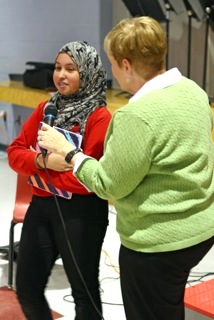
- Developing language skills (oral and written) and creativity;
- Building confidence and a sense of humor when speaking in front of others;
- Confronting mental health and well being issues;
- Learning the difference between helpful and hurtful humor (and sarcasm’s nasty cousin, bullying).
One of the surprises from the students came when a few of them voiced a request to not limit participation by selecting only the “best” to perform, but to encourage all types of students to take part. Each student was to perform for his or her classmates in small groups, and two or three acts from each class would be chosen to perform in the final Showcase.
Have you heard the one about . . .
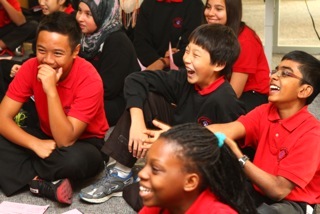
- One, two or three performers in an “act”;
- Rehearsed short sketches or skits of three to five minutes in length with a set-up, a story and punchline or twist at the end;
- Appropriate, non-hurtful humor. “If you wouldn’t want your grandmother to see this, don’t put it in your act.”
The whole object of comedy is to be yourself, and the closer you get to that, the funnier you’ll be. – Jerry Seinfeld
Whose line is it, anyway?
For our second workshop, we were able to involve two local comedians, Tyler Morrison and Marc Trinidad, who shared their varied experiences and tips for success. In particular they distinguished between unrehearsed “improv comedy” and stand up comedy where the performer practices their set up and punchline. Some students who tried to wing it with improv were surprised to learn that it didn’t work as well as they predicted. Students were invited to stand up and share the routine they were working on.
We were impressed with the natural comedic intelligence we witnessed, just waiting to be released. We used a Giggleometer rating scale (1 to 5) for the routines we saw on videos and in live performances. Everyone learned that there are different jokes for different folks. Some classes used blogs to share internet sources of inspiration and ideas. The teachers continued to coach and mentor students to bring out their funny side and talk about appropriate humor. Each class used a couple of copies of the Kidding Around book for reference.
And now, for the first time before a live audience . . .
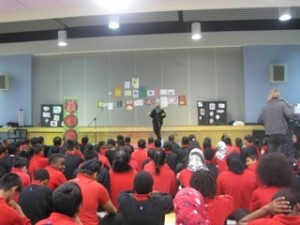
- Use a notebook to jot down raw material before you forget.
- Be yourself and talk about your world.
- Watch for funny things that happen around you and write about that.
- Rehearse, rehearse, rehearse. Work out your timing.
Their other concern was how to find the courage to deal with being nervous. They had to first realize that it’s normal to feel nervous. Then we talked about:
- being prepared and rehearsed;
- loosening up their funny bones by jumping up and down;
- going up on the stage and practicing with a microphone;
- visualizing success and finding some friendly faces in the audience;
- smiling and breathing deeply before going on stage.
One teacher shared a reassuring story about on boy whose sketch evolved and improved many times as he reworked the lines in preparation for his live performance. Student blogs and comments tracked their range of feelings as the project unfolded. Here are a few samples:
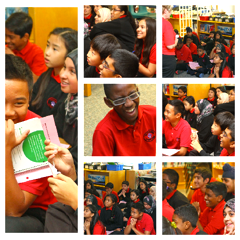
– I’m totally pumped for our sketch. Can’t wait!!! You don’t see many schools doing these types of things, and I am SUPER grateful for being exposed to a subject new to me.
– I honestly really, really, REALLY love this assignment. It’s allowing me to reach out of my comfort zone, which usually doesn’t happen.
– This is a great chance for really shy kids to break out of their shell and also for the jokers and class clowns to express themselves.
– How can I be funnier and find my inner comedian?
– These were the fastest two months of my life. I feel kinda sad about this coming to an end.
The logo contest entries were posted and students voted on their favorites. Because the school mascot is a Cougar Cub, a logo featuring “North Kipling Comedy Cubs” was perfect. Through a press release, the media was invited to attend the final showcase.
What a laughable experience it was!
My parents want me to happy. And a doctor. – Alim
A critical part of the success of the Showcase were the two run-throughs we staged before the real event. The teachers and I gave support and feedback to each act. The day of the Showcase brought out the best in most of the young comedians. The program and content the kids chose included stories about types of parents, out of control shopping experiences, social media, and experiments gone wrong — just to name a few.
Canadian CBC TV picked up the story and the videographer arrived early on the morning of the Showcase. She even spent time with the kids filming their stories after it wrapped up. You can check out the CBC coverage on YouTube!
This experience with the teachers and students was a highlight of my career. Their faces tell the whole story. I encourage you to learn from our experience and try this in your own classrooms or schools or living rooms. You could start small and just get your feet wet — or you could jump in the deep end and ride the waves of comedy.
To laugh at comedy on TV or in the movies is one thing, but to write and perform comedy in front of others is a unique experience. Students agreed that they were all winners for performing in front of an audience of their peers.
North Kipling JMS students and teachers hope this pilot project becomes an annual event. Plans are in the works to add a few more schools and involve more professional comedians. As one of the teachers Doug Cornell said: “We’re on to something new and good here!”
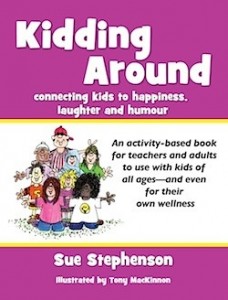

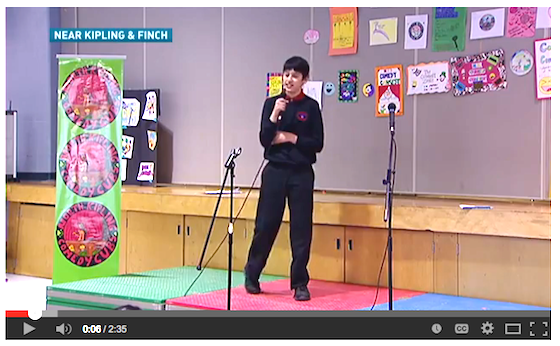


































As you recognize, great stand-up requires great speaking. Let me suggest my book Well Spoken: Teaching Speaking to All Students (Stenhouse Publishers, 2011) as a way to teach students to use speed, inflection and gesture well, and more. Little lessons in that book will make a big difference at show time.